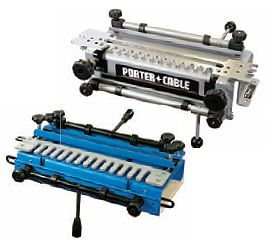Tool Test: Half-Blind Dovetail Jigs
These basic but dependable router jigs deliver half-blind dovetails with fixed spacing
There is a wide variety of router jigs designed for cutting dovetails. Some can cut both of the common types: through-dovetails and half-blind dovetails. Some allow variable spacing of the pins and tails. Many offer alternate templates for cutting finger joints or sliding dovetails. Others are very wide for dovetailing deep carcases. Since there are at least 20 different jigs on the market, the editors of Fine Woodworking decided to split them into two groups.
In Fine Woodworking #187, Tim Albers evaluated the 13 most versatile router dovetail jigs on the market that can produce through-dovetails and variably-spaced pins and tails. For this Web-based feature, I evaluated the simplest, most affordable, dovetail jigs — seven in all — which cut half-blind dovetails with fixed spacing, on workpieces that are 12 in. wide or less.
| Simple jigs are still versatile Before you dismiss the simpler systems, consider that they are appropriate for many projects. They are great for drawers, bookcases, small cabinets, and boxes, and the best of them will crank out dozens of perfect joints in an hour or two. Also, a half-blind dovetail jig cuts both workpieces in one setup, as opposed to a through-dovetail jig, which cuts each part separately.Finally, consider the fact that no matter how versatile the jig, machine-cut dovetails will always have pins that are as thick as the router bit that cut them. With some practice, through dovetails with thin, elegant pins and varied spacing can be cut by hand in less time that it takes to set up one of the high-end jigs. All jigs can make precise joints, but not all do it easily Because most of you don’t cut dovetails every day, or every month for that matter, you’ll often need a little refresher when you use the jig. So I put a lot of emphasis on the quality of the manual and the ease of adjustment. All of these jigs are capable of making joints on stock up to 12 in. wide. However certain widths will produce a more attractive joint, with symmetrical half-pins at each end. In general this means sticking to widths in 1-in. increments. |
 |
CMT 300 Dovetail Jig |
 |
General International 40-010 Dovetail Fixture | |
 |
Porter-Cable 4210 Dovetail Jig | |
 |
Rockler 62525 Dovetail Jig | |
 |
Woodhaven 7500 Dovetail Jig | |
 |
Woodstock International H0983 Dovetail Jig | |
 |
Woodtek 122-471 Dovetail Jig |
Generally, setup is straight forward
Because both parts of the joint are cut in one pass, the pins board must be offset from the tails board by 1/2 in. On some jigs the offset guides for the pins and tails boards are a single unit; on others they must be adjusted individually, which is fussier. On two jigs, the guides are completely fixed, so you must stick to just a few very precise stock widths in order to get symmetrical joints.
Also because both sides are cut in one pass, the length of the grooves between the pins must be set correctly for the joint to end up flush. This is accomplished on some jigs by adjusting a rear fence that the router base butts up to at the end of each cut. On other jigs the length of the groove is set by the front-to-back location of the template. I found the template adjustment easier, especially on the CMT and Porter-Cable jigs, which provide built-in guide lines on the template that you set to the edge of the material.
Workpieces must be clamped and unclamped often, so it is critical that the stops, fences, templates, and workpieces are easy to set in their proper position, and that they stay there.
As for securing the jig itself, I prefer mounting it on a piece of plywood and clamping that to the bench, rather than drilling holes in my work surface.
On all of the jigs the height of the router bit determines the tightness of the finished joint, and the height must be adjusted exactly to the value specified for each jig. I found that a small, shop-made gauge block makes this initial setup much easier. Only the Porter-Cable jig has a built-in depth guide.
Also, keep in mind that some packages include the bits and template guide bushings in the base price; other don’t. Also, some have the capacity to make rabbeted dovetails, which create a lipped drawer front. Others have the capacity to make box joints, through-dovetails, or other sizes of half-blind dovetails. Check the specs to see which templates are standard and which are available as accessories.
Three jigs stand out
My clear choice for the Best Overall award is the Porter-Cable 4210. It is well-engineered and manufactured, it is very easy to set up for several types of joints, and it has excellent instructions. It is also the only system that uses a 1/2-in.-shank router bit, which offers less vibration that 1/4-in.-shank bits. For Best Value, my choice is the Rockler jig. It is a very good product at an attractive price. It’s straightforward to set up, and it has an excellent manual.
Also worth a closer look is the Woodhaven, which offers unique features that could be especially useful to some woodworkers: it uses a bearing-guided bit that works on any router (as opposed to the template guide bushings on other systems), and it can be used in the inverted position on a router table.
Fred Sotcher is a woodworker in San Jose, Calif.
Fine Woodworking Recommended Products

Starrett 12-in. combination square

Stanley Powerlock 16-ft. tape measure

Estwing Dead-Blow Mallet






















Log in or create an account to post a comment.
Sign up Log in